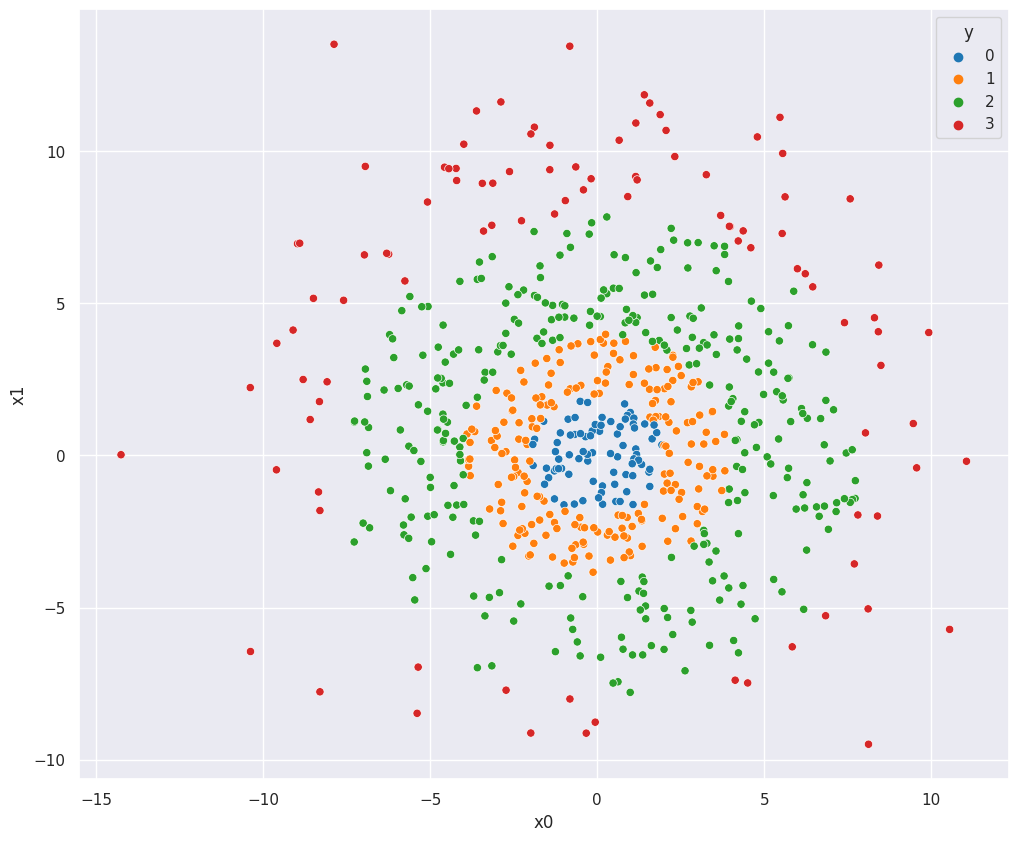Cross Validation#
import numpy as np
import pandas as pd
from sklearn.model_selection import cross_val_score
from sklearn.ensemble import RandomForestClassifier
import seaborn as sns
import matplotlib.pyplot as plt
sns.set(rc={'figure.figsize':(12, 10)})
Create Fake Data#
np.random.seed(1234)
df = pd.DataFrame({
"x0":np.random.normal(0,4,700),
"x1":np.random.normal(1,4,700),
})
radius = np.sqrt(df["x0"]**2 + df["x1"]**2)
circles = [
[0,2],
[2,4],
[4,8],
[8,np.inf],
]
df["y"] = 0
for i,circle in enumerate(circles):
df.loc[radius.between(circle[0],circle[1]), "y"] = i
X = df[["x0","x1"]]
y = df["y"]
sns.scatterplot(X["x0"], X["x1"], hue=df["y"], palette="tab10")
df = df.sample(len(df), replace=False)
/home/chansoo/projects/statsbook/.venv/lib/python3.8/site-packages/seaborn/_decorators.py:36: FutureWarning: Pass the following variables as keyword args: x, y. From version 0.12, the only valid positional argument will be `data`, and passing other arguments without an explicit keyword will result in an error or misinterpretation.
warnings.warn(

Cross Validation Using sklearn#
Create the classifier object, then use sklearn.cross_val_score to cross validate.
The cv parameter is used to determine splitting strategy. The default is cv=5, which
uses 5-fold cross validation.
clf = RandomForestClassifier(max_depth=2, random_state=0)
scores = cross_val_score(clf, X, y, cv=5, n_jobs=15)
scores
array([0.69285714, 0.63571429, 0.62142857, 0.67857143, 0.72857143])
Cross Validation Manually#
Would never actually do this, but for instructional purposes, manually conduct 5-fold cross validation.
Algorithm:
Divide observations into \(k\) folds
Use first fold as test set and fit model on remaining \(k-1\) folds
Repeat \(k\) times
folds = 5
df["folds"] = np.repeat([x for x in range(folds)], len(df) // 5)[:700]
score = []
for fold in range(folds):
test = df.loc[df["folds"]==fold]
train = df.loc[df["folds"]!=fold]
clf = RandomForestClassifier(max_depth=2, random_state=0)
clf.fit(X=train[["x0","x1"]], y=train["y"])
score.append(np.mean(test["y"] == clf.predict(test[["x0","x1"]])))
score
[0.6714285714285714,
0.6357142857142857,
0.7,
0.7214285714285714,
0.6857142857142857]